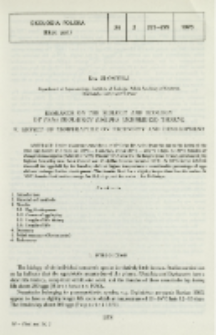- Wyszukaj w całym Repozytorium
- Piśmiennictwo i mapy
- Archeologia
- Baza Młynów
- Nauki przyrodnicze
Wyszukiwanie zaawansowane
Wyszukiwanie zaawansowane
Wyszukiwanie zaawansowane
Wyszukiwanie zaawansowane
Wyszukiwanie zaawansowane

Obiekt
Tytuł: Research on the biology and ecology of Panagrolaimus rigidus (Schneider) Thorne. 5, Effect of temperature on fecundity and development
Inny tytuł:
Effect of temperature on fecundity and development ; Biology and ecology of Panagrolaimus rigidus
Współtwórca:
Polska Akademia Nauk. Instytut Ekologii
Wydawca:
Miejsce wydania:
Opis:
Strony 273-279 : ilustracje ; 24 cm ; Bibliografia na stronie 279 ; Streszczenie w języku polskim
Typ obiektu:
Abstrakt:
Under laboratory conditions at 10°C the life cycle (from the egg to the laying of the first egg) lasted 37.7 days, at 20°C – 14.6 days, and at 30°C – only 9.1 days. At 20°C females of Panagrolaimus rigidus (Schneider 1866) Thorne 1937 were for the longest time fecund and showed the highest fecundity rate. Least fecund were P. rigidus females reared at 10°C. At 10°C larvae hatched from all the eggs laid by the females, while at higher temperatures a considerable percentage of eggs did not undergo further development. The females lived for a slightly longer time than the males. At 10°C females lived on the average for 61.8 days, and the males – for 50.0 days.
Bibliografia:
1. Fischer J.M. 1969 - Investigation on fecundity of Aphelenchus avenae - Nematologica, 15: 22-28.
2. Hirschmann H. 1960 - Reproduction of nematodes (In: Nematology fundaments and recent advances with emphasis on plant parasitic and soil form. Eds. J. N. Sasser and W.R. Jenkins) - The University of North Carolina Press, Chapel Hill, 341-419.
3. Hirschmann H. 1962 - The life cycle of Ditylenchus triformis with emphasis on post embryonic development - Proc. helminth. Soc. Wash. 29: 30-43.
4. Huang C. S., Huang S. P., Lin L. P. 1972 - The effect of temperature on development and generation periods Aphelenchoides besseyi - Nematologica, 18: 432-438.
5. Kampfe L., Schmidt F. W. 1966 - Zucht und Verendung von Nematoden als Versuchtiere. III. Einzel und Parchenhaltung von Rhabditis oxycerca de Man, 1865 - Z. Versuchstierkun. 8: 217-226.
6. Kozłowska J., Domurat K. 1971 - Research on the biology and ecology of Panagrolaimus rigidus (Schneider) Thorne. III. Plant influence on development of P. rigidus populations - Ekol. pol. 19: 715-723.
7. Mamiya Y. 1971 - Effect 6f temperature on the life cycle of Pratylenchus penetrans on Cryptomeria seedlings and observations on its reproduction - Nematologica, 17: 82-92.
8. Mianowska E. 1976 - Research on the biology and ecology of Panagrolaimus rigidus (Schneider) Thorne. IV. Effect of temperature and soil moisture on the growth and structure of a population - Ekol. pol. 24: 2.63-271.
9. Popovici J. 1972 - Studies on the biology and population development of Cephalobus persegnis (Nematoda, Cephalobidae) in agar culture - Pedobiologia, 12: 123-127.
10. Rhode R. A., Jenkins W. R. 1957 - Effect of temperature on the life cycle of subby-root nematodes - Phytopathology, 47: 29.
11. Thomas P. 1965 - Biology of Acrobeles complexus Thorne, cultivated on agar - Nematologica, 11: 395-408.
12. Wallace H. R. 1963 - The biology of plant parasitic nematodes - Edward Arnold LTD, London.
13. Wilski A. 1967 - Nicienie szkodniki roślin uprawnych - PWRiL, Warszawa, 336 pp.
14. Yuksel H. 1960 - Observations on the life cycle of Ditylenchus dipsaci on onion seedlings - Nematologica, 5: 289-296.
Czasopismo/Seria/cykl:
Tom:
Zeszyt:
Strona pocz.:
Strona końc.:
Szczegółowy typ zasobu:
Format:
Identyfikator zasobu:
Źródło:
MiIZ PAN, sygn. P.2840 ; kliknij tutaj, żeby przejść
Język:
Język streszczenia:
Prawa:
Licencja Creative Commons Uznanie autorstwa 3.0 Polska
Zasady wykorzystania:
Zasób chroniony prawem autorskim. [CC BY 3.0 PL] Korzystanie dozwolone zgodnie z licencją Creative Commons Uznanie autorstwa 3.0 Polska, której pełne postanowienia dostępne są pod adresem: ; -
Digitalizacja:
Muzeum i Instytut Zoologii Polskiej Akademii Nauk
Lokalizacja oryginału:
Biblioteka Muzeum i Instytutu Zoologii PAN
Dofinansowane ze środków:
Dostęp:
Kolekcje, do których przypisany jest obiekt:
- Repozytorium Cyfrowe Instytutów Naukowych > Kolekcje Partnerów > Muzeum i Instytut Zoologii PAN > Czasopisma
- Repozytorium Cyfrowe Instytutów Naukowych > Piśmiennictwo > Czasopisma/Artykuły
Data ostatniej modyfikacji:
4 lut 2025
Data dodania obiektu:
3 lip 2019
Liczba pobrań / odtworzeń:
135
Wszystkie dostępne wersje tego obiektu:
https://rcin.org.pl./publication/86765
Wyświetl opis w formacie RDF:
Wyświetl opis w formacie RDFa:
Wyświetl opis w formacie OAI-PMH:
Obiekty Podobne
Mianowska, Ewa
Mianowska, Ewa
Ziabicki, Andrzej (1933– ) Jarecki, Leszek
Węgleńska, Teresa
Wasilewska, Lucyna
Wicher, Jerzy (1936– ) Oliferuk, Wiera Sitarek, Ireneusz Tirinda, Peter Chmurny, Rudolf
Gadaj, Stefan Paweł Gałkowska, Elżbieta Kaczmarek, Jan Oliferuk, Wiera
Podogrodzka, Małgorzata

 INSTYTUT ARCHEOLOGII I ETNOLOGII POLSKIEJ AKADEMII NAUK
INSTYTUT ARCHEOLOGII I ETNOLOGII POLSKIEJ AKADEMII NAUK
 INSTYTUT BADAŃ LITERACKICH POLSKIEJ AKADEMII NAUK
INSTYTUT BADAŃ LITERACKICH POLSKIEJ AKADEMII NAUK
 INSTYTUT BADAWCZY LEŚNICTWA
INSTYTUT BADAWCZY LEŚNICTWA
 INSTYTUT BIOLOGII DOŚWIADCZALNEJ IM. MARCELEGO NENCKIEGO POLSKIEJ AKADEMII NAUK
INSTYTUT BIOLOGII DOŚWIADCZALNEJ IM. MARCELEGO NENCKIEGO POLSKIEJ AKADEMII NAUK
 INSTYTUT BIOLOGII SSAKÓW POLSKIEJ AKADEMII NAUK
INSTYTUT BIOLOGII SSAKÓW POLSKIEJ AKADEMII NAUK
 INSTYTUT CHEMII FIZYCZNEJ PAN
INSTYTUT CHEMII FIZYCZNEJ PAN
 INSTYTUT CHEMII ORGANICZNEJ PAN
INSTYTUT CHEMII ORGANICZNEJ PAN
 INSTYTUT FILOZOFII I SOCJOLOGII PAN
INSTYTUT FILOZOFII I SOCJOLOGII PAN
 INSTYTUT GEOGRAFII I PRZESTRZENNEGO ZAGOSPODAROWANIA PAN
INSTYTUT GEOGRAFII I PRZESTRZENNEGO ZAGOSPODAROWANIA PAN
 INSTYTUT HISTORII im. TADEUSZA MANTEUFFLA POLSKIEJ AKADEMII NAUK
INSTYTUT HISTORII im. TADEUSZA MANTEUFFLA POLSKIEJ AKADEMII NAUK
 INSTYTUT JĘZYKA POLSKIEGO POLSKIEJ AKADEMII NAUK
INSTYTUT JĘZYKA POLSKIEGO POLSKIEJ AKADEMII NAUK
 INSTYTUT MATEMATYCZNY PAN
INSTYTUT MATEMATYCZNY PAN
 INSTYTUT MEDYCYNY DOŚWIADCZALNEJ I KLINICZNEJ IM.MIROSŁAWA MOSSAKOWSKIEGO POLSKIEJ AKADEMII NAUK
INSTYTUT MEDYCYNY DOŚWIADCZALNEJ I KLINICZNEJ IM.MIROSŁAWA MOSSAKOWSKIEGO POLSKIEJ AKADEMII NAUK
 INSTYTUT PODSTAWOWYCH PROBLEMÓW TECHNIKI PAN
INSTYTUT PODSTAWOWYCH PROBLEMÓW TECHNIKI PAN
 INSTYTUT SLAWISTYKI PAN
INSTYTUT SLAWISTYKI PAN
 SIEĆ BADAWCZA ŁUKASIEWICZ - INSTYTUT TECHNOLOGII MATERIAŁÓW ELEKTRONICZNYCH
SIEĆ BADAWCZA ŁUKASIEWICZ - INSTYTUT TECHNOLOGII MATERIAŁÓW ELEKTRONICZNYCH
 MUZEUM I INSTYTUT ZOOLOGII POLSKIEJ AKADEMII NAUK
MUZEUM I INSTYTUT ZOOLOGII POLSKIEJ AKADEMII NAUK
 INSTYTUT BADAŃ SYSTEMOWYCH PAN
INSTYTUT BADAŃ SYSTEMOWYCH PAN
 INSTYTUT BOTANIKI IM. WŁADYSŁAWA SZAFERA POLSKIEJ AKADEMII NAUK
INSTYTUT BOTANIKI IM. WŁADYSŁAWA SZAFERA POLSKIEJ AKADEMII NAUK




































